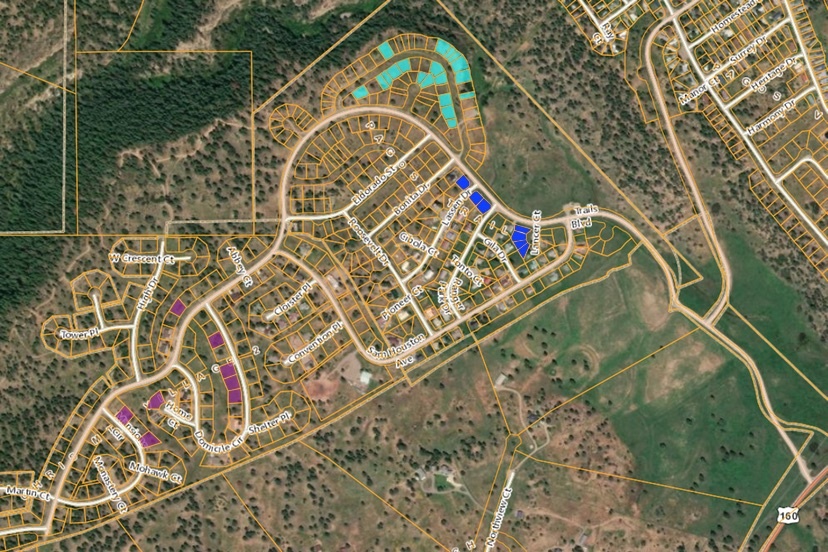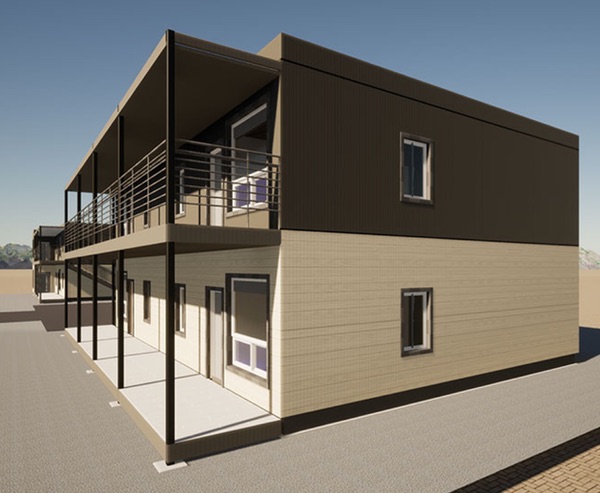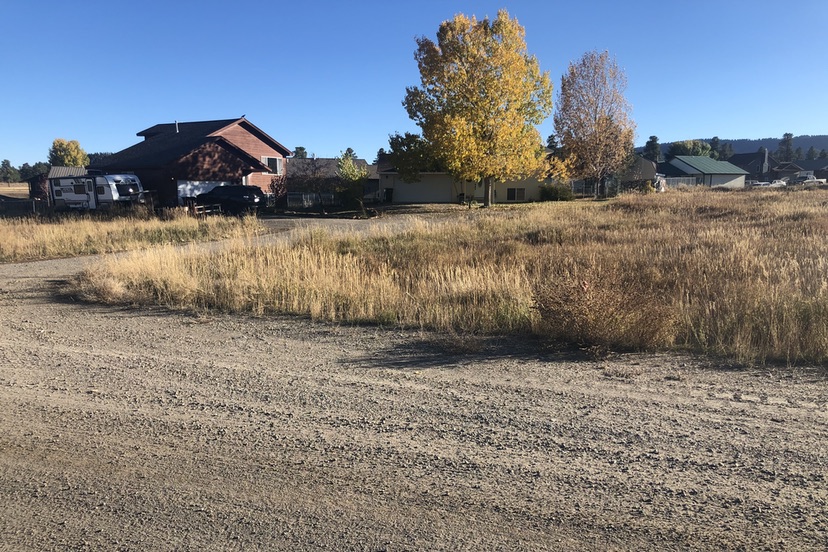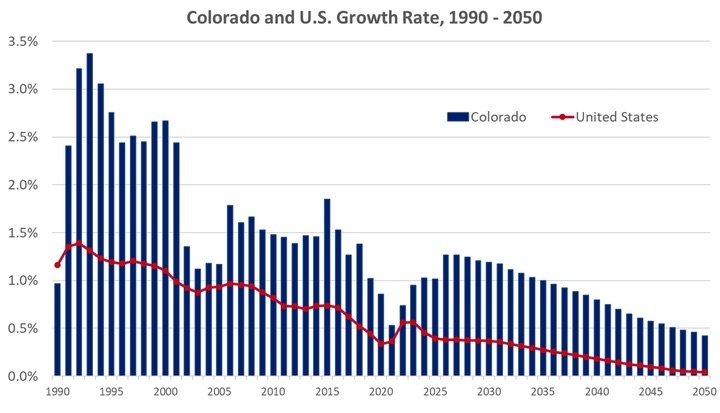PHOTO: Wild grasses cover four small vacant lots near the entrance to Pagosa Trails subdivision, facing on a rustic cul-de-sac. The Pagosa Springs Community Development Corporation hopes to someday see four new homes built here.
A Daily Post reader sent me a link, yesterday, to an article by Tamara Chuang in the online Colorado Sun. Ms. Chuang writes a column called “What’s Working” focused on the Colorado job market and workforce issues. Her October 7 article covered some demographic predictions for the state of Colorado as a whole, as presented by State Demographer Elizabeth Garner.
Over the past several decades, Colorado’s population has been boosted by young adults, aged 22 to 37, moving to the state. But according to current trends, American women are having fewer babies (for whatever reason)… so there will be fewer young people migrating to Colorado, and the average age of the incoming population will increase. As the state’s average age increases, the death rate will rise. And slowly, people will stop moving to Colorado.
Before I share the next couple of graphs, I should clarify that, since I began writing for the Daily Post in 2004, the Colorado Demographer’s Office has consistently overestimated population growth in Archuleta County… by a sizable margin of error.
Our humor columnist, Louis Cannon, confessed this week that he doesn’t believe in statistics. I will confess the same lack of faith. Nevertheless, the graphs are colorful and entertaining.
This next graph shows the Demographer’s expectation for households in the state of Colorado. What kinds of households will we have here, in 2050?
Mostly, single people and couples who have no “kids”. By 2050, 2.3 million households with no kids. 1 million households with kids. Children will become an increasingly unpopular household item over the next 25 years. Or so the Demographer’s Office is predicting.
I find the labels for the third and fourth columns — “Two or more adults” — to be interesting. I assume “…or more…” generally means, “Two adults caring for one or more elderly parents” or perhaps “Two adults, living with their adult children who can’t find anywhere else to live.”
The next graph shows the predicted population growth rate for Colorado (blue bars) and for the U.S. (red line). The U.S. will stop growing completely by 2050 — not because we ran out of space, but for other reasons. Colorado will somehow keep growing its population. But much more slowly than the 3% growth we saw in the early 1990s.
I was amused to see that the peak of Colorado’s growth rate took place in 1993… the very year Clarissa and I moved our family here.
Predictions about population changes are easy to make. (Ask me how I know.) But when you go beyond three years, you are practically guaranteed to be wrong. When you try to go out 27 years, you’re likely to do worse than a fortune teller with a crystal ball.
Which is why I pulled out my crystal ball to begin this editorial series. But it was dark, and cloudy.
As I suggested to the Archuleta Board of County Commissioners, during public testimony at their regular meeting this week, we are all trying to do our best for our community. I was including our three County commissioners in that assumption.
We have different ideas of what “best” means, however.
For some people, “best” means protecting personal property values and personal wealth, regardless of the overall effect on the community. For others of us, “best” means a diverse community, where — among other things — working families can live reasonably close to their place of employment, and don’t have an hour-long commute, to drive to a job that pays $16 an hour.
We are listening here to Pagosa Springs Community Development Corporation (CDC) Executive Director Emily Lashbrooke addressing her board of directors on October 11:
“Okay. Workforce housing project. This is our big topic today… Archuleta County donated another 27 lots to our [CDC] workforce housing project…out in Chris Mountain II…”
According to my reading of the map Ms. Lashbrook kindly provided to the Daily Post, I see eight vacant parcels in Chris Mountain subdivision that were donated to CDC by the Archuleta Board of County Commissioners (BOCC)… and I’ve indicated those in purple in the map below. The CDC hopes to have homes built on those eight lots next year, if willing builders can be found to build them.
But this map actually shows two subdivisions: Pagosa Trails in the middle (where the turquoise and blue properties are located) and Chris Mountain to the lower left (where the purple properties are located.)

Ms. Lashbrooke told her volunteer board that the planned affordable homes would likely be priced at $325,000 to $395,000. That is to say, affordable for a household making $100,000 a year, or more.
After hearing Ms. Lashbrooke’s presentation, I visited the Pagosa Lakes Property Owners Association offices, to get a better understanding of the particular CC&Rs — the Covenants, Conditions, and Restrictions — that control development in the Chris Mountain subdivision. I wasn’t merely curious. I’m currently president of Pagosa Housing Partners (PHP), a non-profit organizations that wrote, in 2019, a plan for the Town of Pagosa Springs, to help our Town Council and their staff more successfully address Pagosa’s housing crisis.
You can download that 54-page plan here.
Disclosure: This editorial expresses only my own opinions, and not necessarily the opinions of the PHP Board as a whole.
Two years later, in 2021, the Town began implementing that housing plan by sending out a Request for Proposals (RFP), inviting developers and non-profits to build affordable housing on two vacant parcels near Town Hall. The Town Council had acquired those vacant parcels expressly for long-term affordable housing.
Pagosa Housing Partners responded to that Town RFP, proposing to build two four-plexes, to be built as modular units in Pueblo, Colorado and assembled here in Pagosa… thus sidestepping a key part of the housing crisis: the shortage of trained construction professionals who can find affordable housing in Pagosa Springs.


Nothing fancy, but affordably decent. We estimated a price per unit at less than $200,000. So, maybe half the price of what the CDC expects in Chris Mountain?
As I discovered, however, the Chris Mountain CC&Rs do not allow four-plexes… nor duplexes, nor townhomes, nor apartments, nor condos, nor mobile homes. Basically, from the vantage point of 2023, the Chris Mountain CC&Rs — written in 1970 and updated in 1981 — prohibit anything really affordable.
Upon receiving the map from Ms. Lashbrooke, I concluded that most of the newly-donated 27 vacant parcels (blue and turquoise) were located in Pagosa Trails subdivision, not the Chris Mountain subdivision.
Same problem. Due to the (outdated?) CC&Rs, a developer can’t afford to build anything truly affordable. Not in 2023; not in our current economy.




